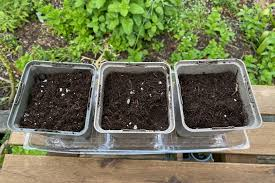Thyme is a must-have in any herb garden, but its versatility makes it a valuable plant for many other parts of the garden too. Not only is it attractive to gardeners, but it’s also a bee-friendly choice. One of the benefits of thyme is that, unlike many herbs, it can be propagated easily, allowing you to grow more of this fragrant plant at no extra cost. Regular propagation can also help maintain its health, as thyme tends to become woody after a few years.
Although growing thyme from seed is an option, it can be slow and unreliable. For a more successful approach, consider taking softwood cuttings, layering, or dividing your plants.
Softwood Cuttings
Softwood cuttings are a great way to propagate thyme from spring to summer. Start by preparing your containers with a 50:50 mix of potting compost and sand. Choose healthy, non-flowering shoots about 5-10cm (2-4 inches) long. Use a sharp knife to take the cutting just below a node (the point where leaves sprout), and strip the leaves from the bottom half of each cutting.
Make a hole in the growing medium with a pencil or dibber and insert the cutting, leaving the leafed end above the surface. Place your cuttings in a propagator or cover them with a clear plastic bag to create a humid environment. Remove the cover daily for fresh air. Keep the cuttings out of direct sunlight and ensure the soil remains moist. In several weeks, roots should form, and once new growth appears, the cuttings can be potted into their own containers.

Layering Thyme
Layering can be done in spring, autumn, or even summer. Start by selecting a low-growing branch from a healthy thyme plant. Strip off the leaves, leaving just a few at the tip. Dig a shallow trench and carefully bend the stem down to the ground. Make a small wound where the stem touches the soil to encourage rooting, then secure it in place with a bent wire. Backfill the trench, leaving the tip above the soil and tying it to a small cane to encourage upward growth.
Keep the area moist, especially in the summer. Within a year, the stem should have developed a strong root system. Once rooted, you can cut the new plant away from the parent and replant it elsewhere or in a container. Alternatively, mound layering involves covering the plant with soil or compost, leaving just the tips exposed. After a few months, roots will form along the stems, allowing you to cut them off and replant.

Dividing Thyme
Thyme can be divided in spring or autumn, with both seasons offering benefits. Spring divisions tend to grow quickly with warmer temperatures, while autumn divisions benefit from a longer rest period before the growing season. To divide thyme, dig up the plant and carefully break it into three or four sections. For stubborn plants, use two hand forks back-to-back to pry the sections apart. Trim back the foliage by half to reduce water loss while the plant re-establishes. Finally, replant the divisions where you want them to grow.
Varieties of Thyme
Thyme comes in a variety of species, each offering unique characteristics. Common thyme (Thymus vulgaris) is hardy and versatile, perfect for herb gardens, raised beds, or rock gardens. Lemon-scented thyme (T. citriodorus) thrives in warmer climates or with some extra care during the winter months. Its fresh lemon scent is ideal for containers or hanging baskets. Creeping thyme (T. serpyllum) is a low-growing variety that’s perfect for a fragrant lawn or between paving slabs, where stepping on it releases its aromatic oils. It’s also ideal for green roofs.
Where do you like to grow thyme in your garden? Share your thoughts with us in the comments!
